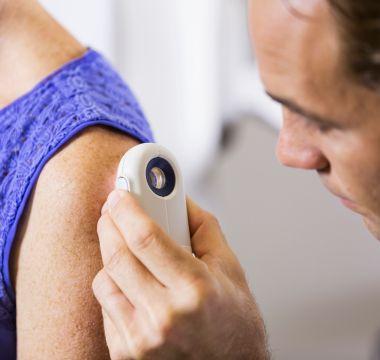A Skin Test Could Detect Parkinson’s and Related Diseases

New research indicates that a skin biopsy could possibly lead to accurate diagnosis of Parkinson’s and other neurodegenerative diseases.
Currently, there is no single test to diagnose Parkinson’s disease (PD). Doctors rely on symptoms, which can mean a delay in diagnosis as early symptoms can be hard to distinguish from other common ailments. A new study in the Journal of the American Medical Association (JAMA) shows that a skin biopsy test can reliably detect Parkinson’s and other related diseases.
Parkinson’s, along with dementia with Lewy bodies (DLB), multiple system atrophy (MSA), and pure autonomic failure (PAF) are four diseases characterized by progressive neurodegeneration and disability. Together this group of diseases are called synucleinopathies because the nerve cells accumulate an abnormal version of the protein alpha-synuclein, which is also referred to as phosphorylated alpha-synuclein (P-SYN).
Previous research indicated that P-SYN could also be found in nerve cells present in the skin. The new JAMA study shows that small amounts of skin taken from the leg, thigh and back of the neck can be analyzed to detect P-SYN in people who have synucleinopathies.
A similar study published last year detected alpha-synuclein in a slightly different test referred to as a seed amplification assay (SAA) analysis . In that study, investigators collected spinal fluid from people with early Parkinson’s. A skin biopsy is considerably less invasive than a lumbar puncture (also known as a spinal tap), which is why this study has generated a lot of interest.
About the Study & Results

The study enrolled 428 participants; 277 were diagnosed with Parkinson’s or another synucleinopathy (DLB, MSA or PAF), along with 151 people who had no history of neurodegenerative disease. Each participant had three skin biopsies that were analyzed in the laboratory.
Of those confirmed to have a synucleinopathy, the biopsies tested positive for P-SYN 92.7% of the time with Parkinson’s, 98.2% with MSA, 96% with DLB, and 100% with PAF. For people who did not have a diagnosis, only 3.3% of the biopsies tested positive for P-SYN.
The researchers also found a correlation between the amount of P-SYN in the biopsies and the severity of the participants’ symptoms.
Biopsy detection of P-SYN was the lowest among those with Parkinson’s (at the rate of 92.7% positive), potentially because there are different subtypes of Parkinson’s or because some genetic causes of Parkinson’s, there may be less P-SYN accumulation. However, study results did not address genetic variations associated with the diagnosis of PD.
However, it’s possible that skin biopsies could detect many cases of Parkinson’s before hallmark symptoms appear — such as tremor and trouble walking. Researchers suspect that P-SYN begins to accumulate in the nerve cells before there are noticeable changes to a person's movement. More research will be needed to confirm this suspicion.
The authors of the study speculated that the 3.3% of the biopsies that tested positive for P-SYN among those who did not have a neurodegenerative disease diagnosis, may indicate the potential for a future synucleinopathy diagnosis. However, longer-term follow-up is needed for confirmation.
More research is needed to determine when P-SYN can be detected in the progression of these diseases, and in those who don’t have symptoms, whether P-SYN detection is always predictive of future disease.
Highlights
- The study looked for a skin biopsy marker of Parkinson’s and other related neurodegenerative diseases, called phosphorylated alpha-synuclein (P-SYN).
- Among those confirmed to have Parkinson’s, 92.7% of the skin biopsies tested positive for P-SYN.
- Among those who did not have a neurodegenerative diagnosis, only 3.3% of the skin biopsies were positive for P-SYN.
- The amount of P-SYN in the biopsies correlated with the severity of the participants’ symptoms.
What does this mean?
This skin test method could be used to detect Parkinson’s and related diseases before symptoms appear. By identifying the disease before symptoms manifest there is a possibility of developing treatments before the condition progresses. With a reliable way to identify these diseases at their earliest stages, researchers could more effectively evaluate potential treatments and hopefully bring them to people living with PD sooner.
Additionally, because the researchers found a correlation between the amount of P-SYN in the biopsies and the severity of symptoms, the test might be used to test whether potential treatments are working. For example, if a drug treatment reduces P-SYN, it could indicate that the treatment is having an effect.
More research is needed before a skin biopsy would be considered useful for someone who does not have symptoms, as we don’t yet know how early the test could detect whether they will likely have Parkinson’s or other related diseases. We also do not know if some people could have P-SYN in their skin, but never develop symptoms.
What do these findings mean to the people with PD right now?
The skin biopsy test is commercially available today. It is called the Syn-One Test® and doctors may use it to confirm a synucleinopathy, which may lead to a Parkinson’s diagnosis. A doctor assesses test results alongside other in-office tests and present symptoms to confirm a Parkinson’s diagnosis. If you are already diagnosed with Parkinson’s disease and respond to levodopa treatment, the skin biopsy will likely not add anything to your current management and would not be necessary.
According to the Syn-One Test® manufacturer, Medicare typically covers 80% of the total fee. Insurance may cover all or some of the test fee.
When diagnosing possible Parkinsonism, instead of the Syn-One Test, a doctor may order a DaT scan. Similarly, a DaT scan does not differentiate between the various forms of parkinsonism. Usually if a doctor orders a test to help confirm a Parkinson’s diagnosis, the test is either the skin biopsy test or a DaT scan — not both.
Talk to your Parkinson’s doctor about the Syn-One Test®. If you have already been diagnosed with Parkinson’s and you are responding to therapy, your doctor will most likely not recommend the test. If you are in the process of being diagnosed or confirming a diagnosis, a neurologist or a neurologist with specialty training in movement disorders if available in your region, may consider this test to confirm a diagnosis of a synucleinopathy. Remember that this test is relatively new, so not all Parkinson’s doctors are utilizing it.
Learn More
The Parkinson’s Foundation believes in empowering the Parkinson’s community through education. Learn more about PD and the topics in this article through our below resources, or by calling our free Helpline at 1-800-4PD-INFO (1-800-473-4636) for answers to your Parkinson’s questions.
Related Materials
Newly Diagnosed Guide
How is Parkinson's Disease Diagnosed?
Neuro Talk: Why Are More People Getting Diagnosed with Parkinson’s?
Related Blog Posts


